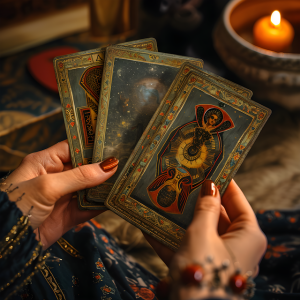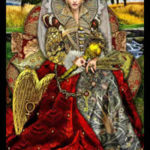Tarot card readings are one of the most well-known and widely practiced forms of divination. For centuries, people have turned to tarot to gain insights, find clarity, and uncover hidden truths about themselves and their lives. But how does this ancient system of symbolic imagery and archetypal storytelling actually work?
In this blog post, we’ll explore the mechanisms behind tarot card readings—from the spiritual to the psychological. Whether you’re a skeptic, a curious beginner, or a seasoned tarot reader looking to deepen your understanding, this guide will take you through the mystical and practical dimensions of tarot.
The Origins of Tarot: A Brief Overview
Before diving into how tarot works, it’s helpful to understand its roots. Tarot originated in the 15th century in Europe as a card game called tarocchi. These early decks were not intended for divination but rather for entertainment. It wasn’t until the 18th century that tarot became associated with the occult and mysticism, especially through the work of esoteric scholars like Antoine Court de Gébelin and Jean-Baptiste Alliette (Etteilla).
Modern tarot consists of 78 cards, divided into two main sections: the Major Arcana (22 cards) and the Minor Arcana (56 cards). These cards are imbued with layers of symbolism, archetypes, numerology, astrology, and mythology, making them powerful tools for introspection and spiritual insight.
Tarot Card Archetypes
The unique picture on each Tarot card represents a universal archetype and gives it a specific meaning. Each tarot card has an upright meaning and a different meaning when displayed upside down.
The appeal of tarot comes from the universal archetypes represented in the images. Yet the power of the tarot comes from the intention and intuitive skill of the person interpreting the cards.
What Happens in a Tarot Reading?
A tarot reading typically involves a question or area of focus, a shuffle, a spread (layout of cards), and the interpretation. Here’s a breakdown of each step:
1. The Question
The process often begins with a question or theme. This can be specific (e.g., “Should I take this new job opportunity?”) or general (e.g., “What do I need to know right now?”). The clarity of the question can shape the clarity of the answer. That said, open-ended questions often work best, as they allow the tarot to speak more freely.
2. The Shuffle
The seeker (or the reader) shuffles the deck to infuse it with their energy and intention. Some readers believe this connects the cards to the subconscious or the divine, while others see it as a symbolic gesture that helps set the stage for introspection.
3. The Spread
Cards are laid out in a spread—a pattern that assigns meaning to each card’s position. The most famous is the Celtic Cross, but other spreads include:
Three-Card Spread (Past, Present, Future or Situation, Challenge, Advice)
Relationship Spread
Career Path Spread
Year Ahead Spread
Each position in the spread represents a specific aspect of the question or life situation, adding another layer of context to the card drawn.
4. Interpretation
This is where the real work begins. The reader looks at each card, considers its traditional meaning, imagery, and position in the spread, and then forms a narrative. Some readers rely heavily on intuition, while others stick closely to the classic meanings. Most combine both approaches.
The Components of a Tarot Deck
To understand how tarot works, it’s essential to know what each part of the deck represents.
The Major Arcana
The 22 Major Arcana cards represent major life events, spiritual lessons, and karmic themes. These are the big energies—birth, death, transformation, awakening. Cards like The Fool, The Tower, Death, and The World point to pivotal life shifts and archetypal journeys.
The Major Arcana can be thought of as the “soul’s journey,” with The Fool (0) symbolizing the beginning of a new path and The World (21) representing completion and integration.
The Minor Arcana
These 56 cards reflect the day-to-day situations and emotions of life. They are divided into four suits:
Cups (Water): Emotions, relationships, intuition
Wands (Fire): Action, creativity, passion
Swords (Air): Thoughts, communication, conflict
Pentacles (Earth): Work, finances, physical world
Each suit runs from Ace (1) to 10, followed by four Court Cards—Page, Knight, Queen, King—which often represent people or personality traits.
How Tarot Card Readings Work: Different Perspectives
There are several theories about how and why tarot works. While they differ in approach, each offers insight into the power of this tool.
1. The Psychological Perspective
From a psychological standpoint, tarot works by tapping into the subconscious mind. Carl Jung, the Swiss psychologist, saw the tarot as a way to access universal archetypes—symbols that exist in the collective unconscious.
When you pull a tarot card, you engage in projection: your mind assigns personal meaning to the card based on your internal state. The cards act like a mirror, reflecting your inner thoughts, desires, fears, and hopes back to you. This can lead to powerful self-awareness and healing.
2. The Spiritual or Mystical Perspective
In spiritual terms, tarot is seen as a tool of divination—communicating with the divine, spirit guides, ancestors, or higher self. Some believe that the cards are guided by a supernatural force that delivers the right message at the right time.
In this view, the shuffle is not random. It’s an orchestrated arrangement by unseen energies that know what you need to hear. Synchronicity plays a key role: the “right” cards appear, not by chance, but by design.
3. The Energetic or Intuitive Perspective
This approach emphasizes energy reading and intuitive flow. The idea is that everything is energy—including thoughts, emotions, and future potential. Tarot readers tune into the energy of the querent (the person asking the question) and the situation, using the cards as focal points for receiving intuitive impressions.
The images, colors, symbols, and even the feelings the reader gets from a card are all part of the message. This is where experience and intuition really come into play.
The Role of the Tarot Reader
While the cards themselves are powerful, the skill and presence of the tarot reader can greatly influence the experience. A good reader is part interpreter, part storyteller, and part guide. Their role includes:
Creating a safe, nonjudgmental space
Helping the querent focus their question
Drawing connections between cards and life events
Offering insights, but not absolutes
Encouraging personal empowerment, not dependency
An ethical reader never claims to predict the future with 100% accuracy or control someone’s fate. Instead, they present possible paths and patterns.
What is a Psychic Tarot Reading?
A psychic tarot reading is a consultation by a professional psychic to offer insight into the client’s life at a moment in time.
Tarot readers use a tarot deck to guide the reading. They draw individual cards from the decks lay them down one at a time.
The meaning of each card, and the order each card appears, provide a unique meaning to the client’s life. The importance and meaning of each card are interpreted by the psychic.
A skilled psychic with a developed sixth chakra can intuitively interpret the universal meaning of the cards and relate them to a client’s life. With the correct intention the information gained from the cards can help a client better understand their life and create a better future for themselves.
Each psychic has unique abilities and will often rely on different psychic techniques during a reading. For example, some professional psychics will use the tarot cards as a trigger for tapping into their psychic unconscious, enabling them to better read a client. A truly gifted psychic may have the ability to consciously communicate with their angels, who help in providing an accurate reading for the client.
The accuracy of a tarot reading will depend on the abilities of the psychic. Anyone who has been to more than one psychic already knows there is a difference in capabilities among tarot readers. Let your intuition guide you choosing a tarot reader wisely.
People often take the time to learn tarot so they can do their own readings. They might watch a video online or read a book to learn what each tarot card means and how it relates to the other cards in the deck.
When reading for himself a person projects his life history and current situation onto the universal meaning of each card. This personal interpretation of the cards may allow a person to consciously understand aspects of himself and his life that were previously hidden in the unconscious.
Most people do not have the highly developed intuitive ability of a professional psychic. As a result, their readings are often less accurate than those done by a talented psychic.
Common Misconceptions About Tarot
1. Tarot Tells the Future
Tarot does not predict a fixed future. Instead, it reveals likely outcomes based on current energies and choices. The future is fluid, and tarot reflects that. It’s more about possibilities than certainties.
2. Tarot Is “Evil” or Linked to Dark Forces
This is a myth rooted in misunderstanding and fear. Tarot is a neutral tool. Like a mirror or a book, its impact depends on how it’s used. Many readers incorporate tarot into spiritual practices that focus on love, healing, and empowerment.
3. You Have to Be Psychic to Use Tarot
While intuitive sensitivity helps, anyone can learn to read tarot. It’s a skill that improves with study, practice, and openness. In fact, learning tarot often enhances your intuition.
Tips for Getting the Most Out of a Reading
Whether you’re receiving or giving a tarot reading, these tips can enhance the experience:
Be Open, Not Passive: Tarot invites conversation, not blind acceptance.
Ask Empowering Questions: Focus on “What can I do?” rather than “Will I get what I want?”
Reflect Afterward: Keep a journal of your readings to track patterns and growth.
Respect the Cards: Treat them with reverence and care—they’re tools of insight.
Practice Self-Compassion: The cards may challenge you, but they’re never out to hurt you.
Tarot as a Tool for Transformation
Ultimately, tarot is not about magic tricks or fortune-telling—it’s about awakening your inner wisdom. The cards don’t hold power over you; they help you reclaim your power by illuminating paths, revealing truths, and offering guidance.
A tarot reading is an invitation: to look inward, to ask better questions, to choose more consciously. Whether you believe in spirit guides or psychology, the value of tarot lies in its ability to open doors to greater awareness and alignment.
Final Thoughts
Tarot card readings work on many levels—emotional, intuitive, symbolic, and spiritual. Whether seen as a mirror of the subconscious, a tool of divine communication, or a canvas for intuition, tarot serves a profound purpose: to help us see more clearly.
It’s not about telling you what will happen; it’s about helping you understand what could happen, and how you might navigate the journey ahead.
So, the next time you sit down with a deck of tarot cards, don’t just ask, “What’s going to happen?” Ask instead, “What do I need to know to create the life I desire?”
The cards are ready. The answers are within you


